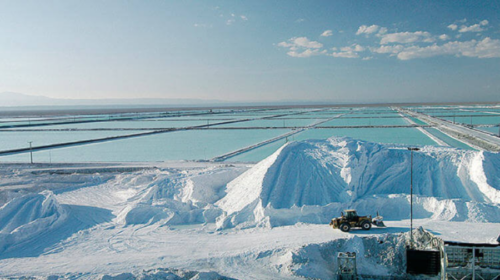Soaring Lithium Prices Lead Tianqi Lithium to Target $1 Billion in Hong Kong IPO

Tianqi Lithium readies for Hong Kong’s largest IPO in 2022 after getting green light from regulators
Key Takeaways:
- Tianqi Lithium expects to go public in July, making it the second lithium company to be listed both in Mainland China and Hong Kong
- As China’s top lithium producer, it needs the money to repay debt taken on during a previous acquisition
By Ken Lo
Lithium prices have risen more than 100% so far in 2022, after more than quadrupling last year. And Tianqi Lithium Corp. (002466.SZ), which says it is one of the world’s largest producers of battery-grade lithium compounds, wants to exploit this trend with a listing as early as next month even though market volatility is keeping investor appetite suppressed.
In addition to the ongoing price momentum, the Chengdu-based company, said it is “well-positioned to capitalize on the new energy revolution globally.” Electric vehicle (EV) sales are predicted to rise 35% to 6.4 million units in 2022 compared with last year, according to Gartner.
Tianqi Lithium has been listed in Shenzhen since 2010. Its mainland shares have doubled in value over the past 12 months, giving it a market cap of around $26 billion, according to FactSet.
Media reports say the company is expected to price its IPO on July 6 and start trading July 13, with the final deal size depending on investor demand. The Wall Street Journal said the company could raise more than $1 billion, which would make it the biggest IPO in Hong Kong so far this year.
This is the second time the company has tried to list in Hong Kong – the first time was in 2018 when it racked up massive debt after an acquisition, but it shelved the plan.
The global lithium market has long been monopolized by international firms, such as Albemarle Corporation (ALB.US), Sociedad Quimica y Minera de Chile (SQM.US) and FMC Corp. (FMC.US). With active support for new energy from the Chinese government in recent years, two local lithium giants – Ganfeng Lithium (1772.HK; 002460.SZ) and Tianqi Lithium – have emerged as big players.
According to the company’s prospectus, it owns two assets – a 26% stake in the Greenbushes Mine in Australia, which is operational, and a 100% stake in the Yajiang Cuola Mine in China, an asset for future development. The company also owns 22.95% of the equity of lithium giant Sociedad Quimica y Minera de Chile (SQM) and is its second largest shareholder.
Cash from the IPO will be used to pay off $1.13 billion in remaining debt from the SQM purchase in 2018. Tianqi Lithium paid $4.07 billion to buy its stake in SQM, a move that weakened the company’s financial position and disrupted expansion plans for factories in Anju and Kwinana.
Second attempt at Hong Kong IPO
Tianqi Lithium had applied for a Hong Kong listing in 2018 but shelved the plan amid falling lithium prices and a cash squeeze after its SQM purchase. This time around, the company’s performance has improved, lithium prices are soaring and the global push for electric vehicles is stoking demand for the commodity.
Revenue rose to 7.6 billion yuan ($1.1 billion) in 2021 from 3.2 billion yuan in 2020. The company recorded a net profit of 4.2 billion yuan in 2021, compared with a net loss of 1.05 billion yuan in 2020 and a net loss of 4.5 billion yuan in 2019. Gross margins of the two major products – lithium compounds and lithium concentrates – exceed 60%.
According to research by Wood Mackenzie quoted in the prospectus, demand for lithium used in batteries for electric vehicles will increase at a compound annual growth rate of 21.2% from 2022 to 2026. In addition, with the Chinese government’s commitment to electric vehicles, lithium has become the new gold for mining companies, with more of them investing to mine and refine lithium.
Tianqi Lithium plans to use money from the listing to expand the first phase of a lithium carbonate plant in Anju District of Suining, Sichuan province in China and the first phase of a lithium hydroxide manufacturing plant in Kwinana in Western Australia.
Tianqi Lithium’s net current liabilities at the end of 2020 increased to 23.5 billion yuan ($3.5 billion). However, with the lithium compound market rebounding last year, the company seems to have come out of its darkest hour, reducing its net current liabilities to 6.1 billion yuan at the end of 2021 after repaying bank loans with A-share financing.
After Tianqi Lithium confirmed the acquisition of SQM in 2018, the average contract price of battery grade lithium carbonate began to decline. Prices kept plummeting in 2019 and 2020 and did not rebound until 2021. According to Wood Mackenzie’s research, the average spot price of battery-grade lithium carbonate in China fell from $8,748 per ton in 2019 to $5,051 per ton in 2020, a decrease of 42%. Prices rebounded sharply to $13,300 per ton in 2021.
In 2022, the price of battery grade lithium carbonate futures broke through 500,000 yuan per ton and has recently been hovering between 460,000 yuan and 480,000 yuan per ton. The industry remains optimistic about price and sales prospects for lithium compounds.
In terms of valuation, the recent price-to-earnings (P/E) ratios of Ganfeng Lithium, Albemarle, FMC Corp. and SQM are between 11.9 times and 91.3 times. Taking an average of about 35 times, Tianqi Lithium’s market cap could reach HK$127.7 billion ($16.4 billion), signaling that a new energy giant could soon be born in the Hong Kong stock market.
To subscribe to Bamboo Works weekly free newsletter, click here





